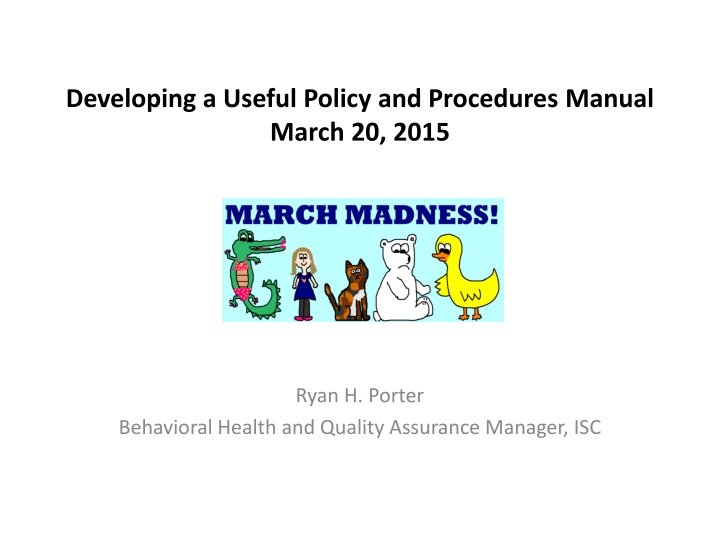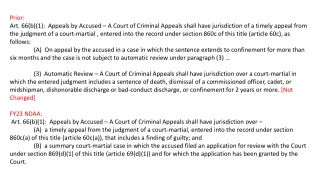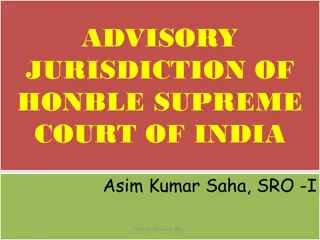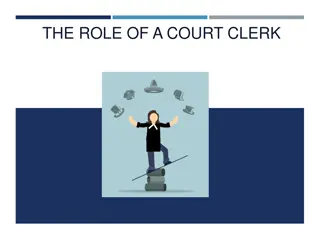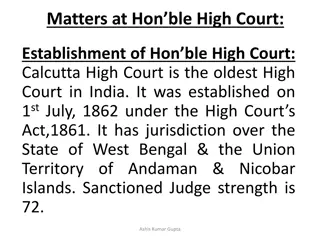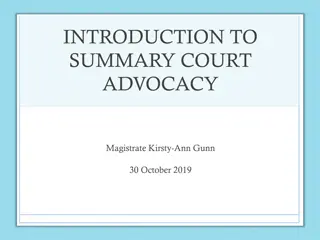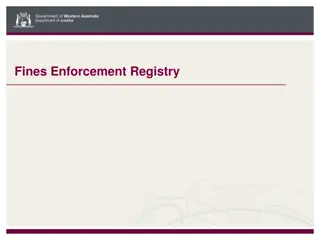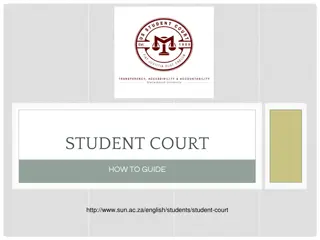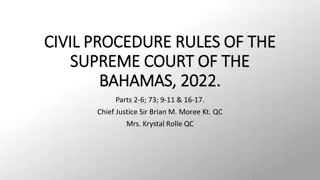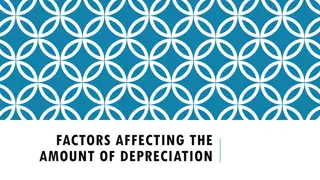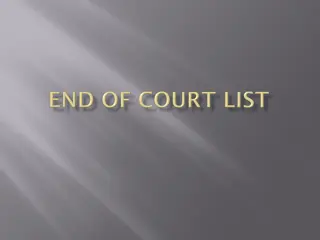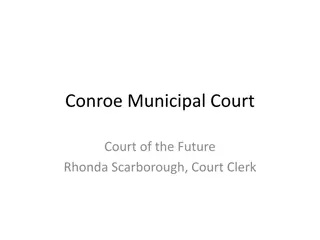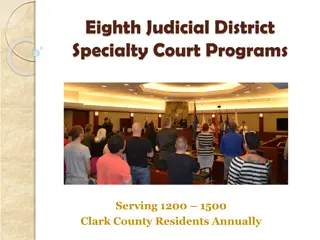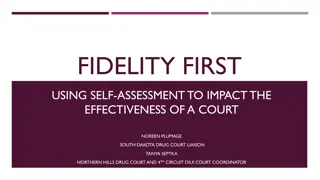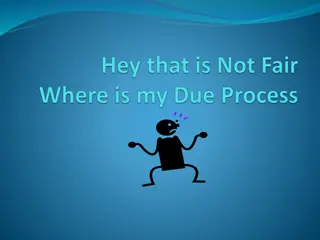Developing a Useful Policy and Procedures Manual for Effective Court Operations
This webinar outlines how to create a comprehensive policy and procedures manual to enhance day-to-day court operations, ensure compliance with state guidelines, promote best practices, and streamline new team member orientation. Participants will learn to define essential policy considerations, organize practices into a structured manual, identify gaps for improvement, and develop an action plan for policy revision.
Download Presentation

Please find below an Image/Link to download the presentation.
The content on the website is provided AS IS for your information and personal use only. It may not be sold, licensed, or shared on other websites without obtaining consent from the author.If you encounter any issues during the download, it is possible that the publisher has removed the file from their server.
You are allowed to download the files provided on this website for personal or commercial use, subject to the condition that they are used lawfully. All files are the property of their respective owners.
The content on the website is provided AS IS for your information and personal use only. It may not be sold, licensed, or shared on other websites without obtaining consent from the author.
E N D
Presentation Transcript
Developing a Useful Policy and Procedures Manual March 20, 2015 Ryan H. Porter Behavioral Health and Quality Assurance Manager, ISC
Webinar Description This webinar will provide participants with a useful outline of a policy and procedures manual that can guide their court s day-to-day operations, maintain operational consistency with state Guidelines and Standards, foster use of best practices and provide a tool to orient new team members.
Learning Objectives: This webinar will enable participants to: define minimum policy and procedural considerations to guide the operations of the individual problem-solving court organize current practice into a useful policy and procedure manual identify gaps in current policy and procedure and develop a plan for updating and revising their policies and procedures
What is a Policy and Procedure? A Policy is a deliberate system of principles to guide decisions and achieve rational outcomes. A policy is a statement of intent, and is implemented as a procedure or protocol A Procedure is a document written to support a policy directive. A Procedure is designed to describe Who, What, Where, When, and Why by means of establishing corporate accountability in support of the implementation of a "policy". Policy lays out what you want participants to do, procedure describe exactly how to do it
How to organize current practice into useful Manual 1. A clear Table of Contents with reference page # s. a. Does it link to the page? b. Are the section titles clear? c. Does it reference the Appendix and Forms? d. Who is your audience? Team member, stakeholders, participants? 2. Chronological order of events, from arrest and admission to graduation and discharge or from theoretical to practical a. Does your manual read from arrest/admission to graduation/discharge? How does it flow? b. Does it begin with mission and philosophy of Drug Court, include 10 key Components? c. Does it finish with application, procedures and protocol? 1. Mission Statement 2.Goals/Objectives 3.Policies and 4.Procedures
How to organize current practice into a useful Manual cont. 3. Keep it direct, simple and objective. a. Does it follow the Idaho Standards and Guidelines? NADCP Standards? 10 Key Components? b. Is it clear and consistent? Or does it ramble and jump topics? c. Strive for clarity, conciseness and coherence 4. Continue to monitor, evaluate and update as new practices emerge and old practices become obsolete. a. What is the frequency and structure for addressing the needs? b. Who is in charge of changes and how are they approved? c. How are changes communicated and implemented? d. Write, edit, re-write, edit, re-write (a living document) e. Make it look good. Appearance and presentation are important.
New Team Member Orientation Train and educate new members in an effort to promote regular review of the manual Helps clarify the unique role on the team for the new member. Allows new member to be consistent with existing practices Provides objective feedback from manual to practice
Drug Court Standard and Guideline 4.10 Each drug court shall have a written drug testing policy and protocol describing how the testing will be administered, standards for observation to ensure reliable specimen collection, how quickly results will be available to the team, the laboratory to be used, procedures for confirmation, and process for reporting and acting on results.
Drug Court Standard and Guideline 4.19 The drug court shall have a written policy and procedure for adhering to appropriate and legal confidentiality requirements and should provide all team members with an orientation regarding the confidentiality requirements of 42 USC 290dd-2, 42 CFR Part 2.
Drug Court Standard and Guideline The standards and guidelines provide a basis for each drug court to establish written policies and procedures that reflect the standards and guidelines, the needs of participants, and the resources available in the community. Each district court shall establish written policies and procedures that describe how the drug court(s) will implement these statewide guidelines as well as any additional guidelines, policies, and procedures necessary to govern its operations.
Tips for a great looking manual Use high quality paper Balance between text and visuals Use photographs and illustrations effectively Use bullet points to offset information from text Provide an appealing cover Include professional binding Prepare a PDF version for electronic distribution
Examples: Table of Contents I. II. III. IV. V. VI. VII. VIII. IX. X. XI. XII. XIII. Mission Statement The Ten Key Components Benefits and Services Offered Drug Court Program Overview Drug Court Program Manual Roles of Drug Court Team Members Staffing and Docket Procedures Pre-Plea Diversion Track Eligibility and Admission Post-Plea Diversion Track Eligibility and Admission Probation Track Eligibility and Admission Re-Entry Track Eligibility and Admission Ineligibility and Termination Procedures Drug Court Graduation Procedures
Example: Mission Statement The mission of the Milwaukee County Drug Treatment Court is to enhance public safety through the reduction of recidivism by coordinating effective and accountable substance abuse treatment and supportive services for offenders with substance abuse problems.
Example: Program Overview The Boone County Drug Court Program is a court-supervised, comprehensive treatment program which accepts participants through various entry tracks. It includes first time non-violent offenders; probationers; and offenders who are returning to the community from the Department of Corrections. All participants have been determined to require substance abuse treatment and are felony offenders. The Drug Court may be a voluntary program or ordered as a condition of probation and parole. Participation includes regular court appearances before the Drug Court Judge. Treatment, which includes drug testing, individual counseling and group counseling, is provided through Reality House for men and McCambridge Center for women. The defendant is also expected to obtain and maintain employment or involvement in vocational or educational programs and maintain regular attendance at 12-step meetings (Narcotics Anonymous or Alcoholics Anonymous). The length of the Drug Court Program is determined by each participant s progress and will be a minimum of one year and no longer than two years.
Example: Policy and Procedure POLICY: It is the policy of the ACJDC that all juvenile participants shall be required to attend weekly Status Hearings in front of the ACJDC Judge. The attendance at these hearings is subject to change based on the juvenile s phase status and ACJDC Team decision. PROCEDURE: In court, the ACJDC-PSC Judge shall review with the juvenile each task successfully completed and those requiring more work to complete. If incentives for compliance or sanctions for non- compliance are called for, the consequence is immediate, appropriate and imposed on an individual basis. The juvenile shall be advised of the next Court appearance date and given a list of tasks and responsibilities for the coming week, if part of the individual sanctions. Families are asked to report on the juvenile s progress with encouragement to report strengths as well as weakness. Participants required at the weekly Status Hearings with the juvenile and the Judge shall be the Prosecuting Attorney, Public Defender, Probation Officer, Drug Court Coordinator and Treatment Counselor(s). Other ADJCS or community liaison representatives involved with the juvenile may attend but are not required to do so. To enhance parental attendance, the weekly Status Hearing shall be held at 3:30 pm on Tuesdays.
References http://county.milwaukee.gov/ImageLibrary/Groups/cntyCourts/documents/Milwaukee_County_Drug_Treatme nt_Court_Policy___ProceduresRev.pdf Milwaukee County Drug Court http://www.stlcitycircuitcourt.com/DrugCourt/Policy%20and%20Procedure%20Manual.pdf St. Louis Drug Courts Policy Manual http://www.montgomerycountymd.gov/circuitcourt/Resources/Files/drugcourt/Adult_Drugcourt_Polici es_and_Procedures_Manual.pdf Montgomery County, Maryland Adult Drug Court http://www.courts.mo.gov/hosted/circuit13/documents/ASC_DCPoliciesAndProceduresManual.pdf Adult Drug Court Missouri
